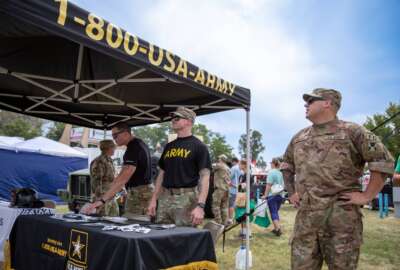House lawmakers want to create Army drone branch
The House draft defense bill requires the Army to establish a Drone Corps. Senior defense officials don't think it's a good idea.
A provision in the House Armed Services Committee’s draft defense policy bill would require the Army to establish a drone corps as a basic branch of the service. But some senior defense officials are not sold on the idea.
“Having a branch, or a [Center of Excellence], or anything like that — it’s not going to help us buy anything faster or get us more resources against this problem set,” Army Undersecretary Gabe Camarillo said during the Center for a New American Security event Friday.
The service currently has 22 branches, each focusing on specific aspects of Army operations. The Corps of Engineers branch, for example, provides engineering support and the Army Finance Corps manages financial operations for the service.
The new branch would oversee programs and projects related to small and medium-sized unmanned aircrafts that weigh less than 1350 pounds and UAS and counter-UAS systems.
The corps would serve as a command center for all drone-related activities. It would help integrate drone systems across the service, conduct research, development, and testing of those systems, and provide personnel with specialized training in such aircraft.
The House Armed Services Committee is scheduled to mark up the defense policy bill next week, and while the provision might be discarded — there is a chance it will be included in the bill.
Camarillo said creating a new institutional structure will distract from the service’s current efforts to bring in those capabilities to soldiers and adopt them more widely across the service.
“I did see the language in the initial draft of the House bill. I would say that it’s animated, I think, by a recognition that this is a very real threat. It is a problem that the department and the Army, in particular, have to confront. We definitely share that focus,” said Camarillo.
“How do you go about it? My view is that creating a corps or other institutional kind of structure to get after it, in some ways, could take away some focus from some of the things that we’re actually doing. It’s important, in my view, to get after giving units these [commercial off-the-shelf] UAS capabilities to let them experiment. I want to better understand the [tactics, techniques and procedures] about how they’re going to employ them at different echelons and to be able to understand how that affects the way that our formations will fight.”
For the past year, Army senior officials have been thinking about ways to reorganize the service’s units and what equipment those units would need.
Army Chief of Staff Gen. Randy George recently introduced a concept dubbed “transforming in contact,” which uses unit rotations to figure out what technologies and capabilities soldiers will need in the future.
Camarillo said efforts such as “transforming in contact” are more likely to help the service better understand what technology they need out in the field and speed up their acquisition processes.
“Things that we’re doing, like transformation in contact, or some of the experiments that we’re performing today, are critically important. I think the institutional implications of, it to me, are secondary at this point, as opposed to figuring out how we’re going to employ the technology and what technology works the best. And most importantly, do we have our buying processes in place in order to be able to get there?” said Camarillo.
When it comes UAS effort, the service recently stood up the joint counter-small unmanned aircraft systems office to provide counter-UAS capabilities to the service. And the Joint Counter Small Unmanned Aerial Systems University trains drone operators.
Copyright © 2024 Federal News Network. All rights reserved. This website is not intended for users located within the European Economic Area.






